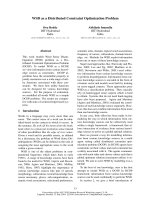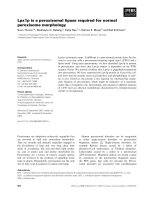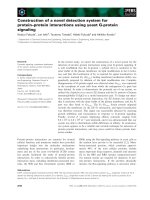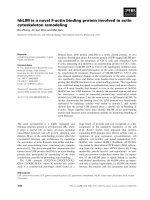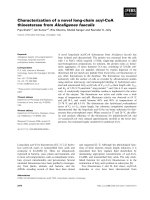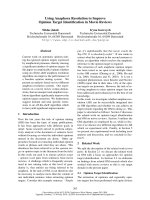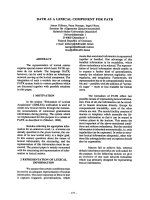báo cáo khoa học: " HIV as a chronic disease considerations for service planning in resource-poor settings" docx
Bạn đang xem bản rút gọn của tài liệu. Xem và tải ngay bản đầy đủ của tài liệu tại đây (248.96 KB, 6 trang )
COM M E N TAR Y Open Access
HIV as a chronic disease considerations for
service planning in resource-poor settings
Lucy Reynolds
Abstract
This paper reviews the healthcare issues facing nations which have a substantial caseload of chronic HIV cases. It
considers the challenges of extending antiretroviral coverage to an expanding caseload as supplier price rises and
international trade agreements come into force to reduce the availability of affordable antiretrovirals just as the
economic downturn restricts donor funding. It goes on to review the importance in this context of supporting
adherence to drug regimens in order to preserve access to affordable antiretrovirals for those already on treatment,
and of removing key barriers such as patient fees and supply interruptions. The demands of those with chronic HIV
for health services other than antiretroviral therapy are considered in the light of the fearful or discriminatory
attitudes of non-specialist healthcare staff due to HIV-related stigma, which is linked with the weakness of infection
control measures in many health facilities. The implications for prevention strategies including those involving
criminalisation of HIV transmission or exposure are briefly summarised for the current context, in which the
caseload of those whose chronic HIV infection must be controlled with antiretrovirals will continue to rise for the
foreseeable future.
Keywords: HIV, Access to essential medicines, Adherence, Antiretroviral, Fees, Stigma, Infection control, Chronic dis-
ease, Intellectual property, Criminalisation
Introduction
In 2009, an estimated 33.3 million [31.4 million-35.3
million] people were living with HIV, according to
UNAIDS[1]. With successful antiretroviral treatment,
life expectancy for people living with HIV (PLHIV) can
be restored to near normal: thus HIV has latterly been
transformed into a manageabl e chronic illness, compati-
ble with fairly good health, lifestyle and economic parti-
cipation. Most countries now have from a few to many
thousands of their population maintained with chronic
HIV infection on antiretroviral treatment (ART). This
situation already causes some significant challenges,
which will increase as the ongoing spread of HIV adds
to the caseload. Much has bee n written about the need
to introduce and scale-up antiretroviral treatment to
prevent deaths from AIDS. Much less has been said
about planning for th e situation when PLHIV have been
stabilised on treatment so that their immunity is largely
restored and they can resume familial and social roles,
although a number of important medical and social
issues emerge at this stage. This paper aims to raise
awaren ess of some of the key questions for health min-
istries and governments.
Discussion
Scope of coverage
As HIV prevalence continues to rise through the roll-
out of highly active antiretroviral therapy (HAART) to
minimise mortality, there will be escalating stress on
health provision. Once HAART has transformed HIV
from an acute to a chronic illness, patients must be sup-
ported in adhering to treatment so that they do not
accumulate resistant virus which can once again impair
immunity and result in acute illness from opportunistic
infections. Further, because chronic HIV infection
results in various forms of organ damage, and because
PLHIV are as vulnerable to unconnected illnesses a s
other people, it is also essential to ensure their access to
general health facilities. The main barrier is the attitude
of health workers: they may be afraid of HIV infection,
and may stigmatise patients known or thought to carry
Correspondence:
Faculty of Public Health Policy, London School of Hygiene and Tropical
Medicine, London, WC1H 9SH, UK
Reynolds Globalization and Health 2011, 7:35
/>© 2011 Reynolds; licensee BioMed Central Ltd. This is an Open Access articl e distributed under the terms of the Creative Commons
Attribution License (http://creati vecommons .org/licenses/by/2.0), which permits unrestricted use , distribution, and reproduction in
any medium, provided the original work is properly cited.
it. Irrational fears and discriminatory attitudes can be
addressed through training, but health care workers
need to be trained and equipped to prevent cross-infec-
tion between those with HIV and uninfected staff or
patients, so as to alleviate unjustified fears and prevent
nosocom ial transmission. The paper also considers cur-
rent strategies to limit transmission from PLHIV,
including the use of legislation. Social ramifications of
high HIV prevalence (for instance loss of key profes-
sional cadres, economic losses, or orphaning) are not
covered because they result mainly from untreated
infections rather than from diagnosed and stabilised
chronic cases.
Extending HAART coverage to an expanding caseload
When symptomatic HIV cases start to emerge in num-
bers, the total cost of managing and treating a national
caseload quickly becomes substantial, because treatment
involves lifelong intake of recently developed drugs and
regular monitoring of their continuing efficacy.
An increasing proportion of the HIV caseload in
developing countries is now able to access free-of-charge
treatment. However, most governments of countries
with generalised epidemics will find it challenging to
cover the future costs of treating the expanding num-
bers of PLHIV, especially now that the recommended
thresholds for commencing treatment have risen. At
present most high prevalence countries can treat only a
minority of those who meet the clinical criteria, even
with substantial external assistance. Over the next few
years, with donor economies providing less assistance
due to the economic downturn[2], budgets will shrink
as demand for HAART grows[3].
The availability of low-cost generic ARVs from India’s
pharmaceutical industry has been criticall y important to
developing countr y treatment programmes over the last
few years, rendering mass treatment achievable. Accord-
ing to the Office of the High Commissioner for Human
Rights, 89% of 2010 supplies to donor-funded HAART
programmes were Indian generics[4-6], alongside 80% of
the ARVs used by Médecins Sans Frontières and the
majority of ARVs supplied through the US government’s
PEPFAR programme[7]. India’s 2005 accession to the
World Trade Organisation (WTO) and resulting signa-
ture of the TRIPS (Trade-Related Aspects of Intellectual
Property Rights) agreement commenced the alignment
of national patent legislation with WTO standards. Dur-
ing the transition period, India has used the public
health provisions of TRIPS, as agreed in the Doha
Round, to maintain export of generic ARVs.
Now a more restrictive free trade agreement with the
European Union is being negotiated, to increase protec-
tion for the international pharmaceutical industry
through strengthening of intellectual property laws. The
change would extend and enhance patent protection for
branded drugs and thus shut down legal production of
some ARVs in India. Fortunately the Indian government
has successfully resisted the incorporation of the TRIPS
data exclusivity clause, but discussions on other ele-
ments continue[8]. Total costs for universal treatment at
national level are likely to increase substantially as the
use of stavudine is discontinued[9] due to its toxicity
[10,11], and as longer-term patients who have developed
resistant virus need to be switched to second-line regi-
mens. A recent study in South Africa[12] determined
the cost of using tenofovir to be about five times that of
the stavudine it replaces. Meanwhile, the manufacturers
of the pa tented versions of many of the commonly used
ARVs are currently reducing the l evel of discounting
they offer to middle-income countries[13].
If the extra money cannot be found to pay higher
prices for ARVs, and the lobbying efforts of the Access
to Essential Medicines Campaign do not succeed, then
formal commitments to full free-of-charge treatment
coverage may have to be revised. Botswana has indicated
that it has already reached this position, with more
PLHIV expected to fund their own treatment in the
future,tosparegovernmentfundsforotherpressing
needs[14].
Supporting adherence to preserve access to affordable
drugs
A patient diagnosed with HIV infection must commence
a daily regimen of pills when CD4 cell levels fall below a
certain threshold. Many PLHIV would prefer to keep
their condition confidential. Ensuring the required level
of adherence (with full adherence defined as all treat-
ments taken within an hour of the correct time, every
day) is hampered by inability to take the pills when
others might observe and guess why they are needed
[15-17]. For the older regimens mainly used in the
developing world, adhere nce poorer than 90-95% is
likely to result in the development of resistant virus
[18-23], while treatment interruptions can also encou-
rage resistance[24].
Patients not fortunate enough to be admitted to a
fundedprogrammemustfindawaytopayfortheir
treatment themselves. Costs can be substantial, with one
study in Uganda finding that each clinic visit repre-
sented approximately 10% of the monthly wage for men,
and 2 0% for women[25,26]. Studies in Botswana, Sene-
gal, Cote d’Ivoire[27] and Uganda[28] have analysed the
rea sons behind low adherence in resource-poor popula-
tions where p atients must pay towards t he cost of their
treatment, and in each of these cases the main reason
stated by patients was the cost of purchasing their medi-
cation. Financial barriers may rise after a patient’scon-
dition is stabilised: when a patient has been critically ill
Reynolds Globalization and Health 2011, 7:35
/>Page 2 of 6
relatives will contribute to transport costs, but this can
rarely be sustained once the illness has become a
chronic but not immediately life-threatening condition
[25].
Patients who are unable to find the funds to renew
their prescription will discontinue treatment temporarily
or permanently, or somehow reduce the cost of their
ARV regimen, for instance by purchasing one or two
ARVs rather than the three needed to protect against
resist ance. Where monotherapy or duo therapy is under-
taken in place of triple therapy as a cost-saving measure,
resistance will develop much faster, as shown by an
Indian study. India has now commenced free first-line
treatment for 340,000 Indian PLHIV, but many patients
have for some time self-funded treatment by private
practitioners. In a study of 279 Mumbai patients pur-
chasing ART, a fifth (54/279) were receiving mono-or
duotherapy, prescribed by private practitioners to allow
them to sell affordable ART for less than the cost of tri-
ple therapy[29]. These drugs are prohibitively expensive
for many: patients who were able to buy treatment
reported spending a median of 60% of their monthly
income on their ARVs. Patients who achieved 95%
adherence or better were three times more likely to reg-
ister viral load below 400 copies/mL than those who did
not, and patients on HAART were more than five times
as likely to achieve this level of viral contro l compared
to those taking mono-or duotherapy. More than a quar-
ter (27%) had not managed to take at least 95% of their
treatment on time, while 30% showed a rebounding
viral load.
Treatment free of charge facilitates patient uptake of
HAART, but failures in the supply line for antiretrovir-
als may also interrupt adherence[30]. In June 2011,
Ghana had to draw down emergency supplies of ARVs
priced at USD1.5 million[31], and in July 2011 protests
occurred in Algeria[32] and Swaziland[33] over ARV
supply problems. Supply interruptions result from seaso-
nal or other transport breakdowns, inadequate systems,
understaffing, and weak management of supply systems
and personnel. Lack of fund s available centrally for pur-
chase of the drugs a lso causes supply interruptions, for
instance because of delays in release of funds from
donor or government budgets. One of the ways that
patients react to these interruptions is to arrange to
share the ARVs of others who are on treatment. This
can result in both donors and recipients lacking enough
drugs to maintain adequate adherence[29].
In poor countries especially, the acquisition of resis-
tant strains may result in patients quickly exhausting
the affordable options for treatment. Such patients
might thus become effectively untreatable unless they
can access the costlier newer ARVs to prevent them
from relapsing from a controlled chronic infection into
an immunodeficient state wh ich results in the develop-
ment of AIDS. It may also increase the possibility of
them transmitting resistant infection to others through
vertical (mother-to-child), sexual or medical routes.
Demands on health services
In addition to the considerable infrastructure needed to
deliver and monitor antiretroviral treatment, and to
address the metabo lic disturbances that it causes (some
of which are life-threatening), a caseload of chronic HIV
patients implies ot her challenges for healt h services.
Treatment of the gradual non-infectious health damage
done by HIV is needed, especially in relation to the car-
diac[34], renal[35] and neurological[36] damage caused
by persistent inflammatory responses. These morbidities
are reduced by HAART in some b ut not all cases[35].
Referral to mainstream health care facilities for these
and for unrelated medical problems will often be neces-
sary; in many countries mainstream clinicians are afraid
of treating people with HIV[37]. A Pakistani PLHIV
reported
“When I take people with AIDS to the hospital, doc-
tors will wear two and sometimes three pairs of
gloves (and) will stay as far away from them as pos-
sible. If doctors are so uncomfortable around us,
what can you expect from those less
knowledgeable?”[38]
Protection of front-line health care staff from con-
tracting dangerous infections at work is a prerequisite
for compassionate ca re for their patients. However,
where providers can limit their own perceived risks of
contracting HIV to levels they fin d acceptable, they may
still exclude PLHIV from fee-for-service facilities, due to
community stigma. Their presence may deter other pay-
ing customers who will fear infection if they become
aware that PLHIV are treated in the same facilities[39].
The staff may then find their institutional and personal
income greatly reduced, and they may be reluctant to
risk this situation by accepting PLHIV as patients[25].
Some healthcare workers hold inappropriate beliefs
about the need for isolation of HIV-posit ive people to
protect other patients[40].
It is important for health care staff to have the sup-
plies needed to pract ice universal precautions. Poor
infection control puts other patients at risk as well as
practitioners: a recent study in Moza mbique found that
of HIV-positive children aged 0-11 years old, 31% of the
mot hers were ser onegative[41], with a significant corre-
lation between seropositivity and having received a med-
icalinjectioninthelastyear[42].InSwaziland,3%of
1665 children age d 2-12 sampled in a general popula-
tion were HIV-positive, and 22% of these had
Reynolds Globalization and Health 2011, 7:35
/>Page 3 of 6
seronegative mothers[43]. Studies in Congo-Kinshasa
[44] and South Africa[45] made similar findings.
Patients with chro nic HIV who have low CD4 counts
are also at risk from poor infection control. For those
with very recent or well-controlled infection the risks
maybeslight,butiftheyhavenotbeenabletoaccess
ART or if their adhere nce has bee n inadequate to con-
trol viral load, they are at risk of acquiring opportunistic
infections from unhygienic health facilities.
However, since t he advent of “structural adjustment”
cuts to health budgets, it is common for developing
country health care systems to be short of of gloves and
disposable equipment, and to lack the means for sterili-
sation of reusable equipment and disposal of contami-
nated sharps[46,47]. WHO has acknowledged that the
sterilisation procedures for reused medical equipment
are inadequate in many developing countries[48].
Medical staff may be able to spearhead the necessary
change in attitudes to PLHIV, once they themselves
have received appropriate training in infection control
and stigma awareness. There is evidence that interacting
with people who are living with HIV can reduce stigma
among both health workers and the general public
[49-51].
Limiting prevalence of chronic HIV over the coming
decades
Limiting the numbers of chronic HIV cases demands an
active engagement with effective prevention, to reduce
the numbers of new cases who will need ART in a few
years. In 2009, according to UNAIDS, there were 2.6
million [2.3-2.8 million] new infections, representing an
8% annual increase in caseload[1].
Some countries have introduced HIV-speci fic criminal
lawstotrytoreduceinfection.Whiletheseareappro-
priate to prevent medical transmission, they pose many
problems when applied to sexual and vertical transmis-
sion. Not only is there no evidence to prove that such
laws do in fact reduce the spread of HIV, but the legis-
lation is often ill-drafted and may for instance: acciden-
tally criminalise conception (e.g. Guinea-Conakry,
Guinea-Bissau, Mali, Niger, Kenya); breach medical con-
fidentiality requirements by enabling or requiring those
carrying out tests to disclose a patient’s HIV+ status to
known or suspected sexual partners (e.g. Benin, Kenya,
Democratic Republic of Congo, Mali, Niger, T anzania,
Togo, Moldova and Papua New Guinea); or block sex
education to young people, (e.g. Guinea-Conakry and
Mali)[52].
Malicious transmission is already illegal in every juris-
diction of the world under pro visions outlawing deliber-
ately harming other people[53], so HIV-specific
provisions covering malicious sexual transmission or
exposure are redundant. It is inappropriate to place
responsibility for blocking further spread of the epi-
demic on to people with chronic infection who have
already been diagnosed and treated: HIV transmission
cannot be blocked by controlling their behaviour or
reducing their liberty because the bulk of tra nsmission
occurs from th ose not yet on treatment, especially those
in primary infection (accounting for 46.5% of all new
infections in the Ugandan Rakai study[54]). Not only is
it doubtful whether HIV can be passed on from PLHIV
whose antiretroviral therapy has succeeded in reducing
their blood viral load to undetectable levels[55], research
shows that one of the effects of HIV diagnosis on
PLHIV is a focus on trying to reduce th e possibility that
the infection could be pass ed on[34,56]. Thus for effec-
tive prevention, attention should be concentrated on
people not so far diagnosed as PLHIV, who behave in
ways that are likely to cause them to contract HIV and
to pass it on once they are infected.
Behaviou r change intervention at a population level is
needed. Lessons must be learned about what works: for
instance models that rely on the individual-focused
health belief model have not proved particularly success-
ful because of inattention to barriers to uptake and to
the impact of local social norms. The widely used ABC
model (abstain, be faithful, use condoms) has had mixed
results, tending to poor results where the C was omitted
from health promotion efforts. The focus of design of
prevention programmes should be on understanding
how traditional and modern belief structures impact
upon behaviour that poses risks to self or to others, in
order to modify prevention messages so that they gener-
ate behaviour change and not stigma. Allen et al present
a more nuanced model for secondary prevention, based
on operational experience, developed in Uganda by
TASO[57]; this study highlights some of the challenges
involved.
Incorrect and irrational beliefs about the causation of
AIDS thrive across the developing world, and can block
assimilation of evidence-based health messages on HIV
even where these are ac curately communicated to the
population. More sophisticated approaches are needed,
focused on communicating insight into personal risks
and on modifying social norms. All HIV programming
should incorporate stigma reduction checks at every
level, as fear of the consequences of exposure of seropo-
sitivity is among the most common reasons for loss of
prevention programme impact as well as treatment
take-up and success[29].
Conclusions
In higher prevalence countries especially, the demands
of managing the response to HIV are heavy, requiring
coordinat ion between ministries of health, donors, logis-
tics teams and local service delivery points. Supportive
Reynolds Globalization and Health 2011, 7:35
/>Page 4 of 6
laws, non-discriminatory health care provision, robust
infection control and reliable drug supply chains are all
needed to support care and treatment for the caseload
of chronic HIV patients. Attention to the affordability of
ARVs is crucial. The decision of the Botswana govern-
ment to leave many patients with chronic HIV to fund
their own treatment through the private sector may
prove to be expensive in cost, morbidity and even mor-
tality in the long term if higher drug resistance results,
as seen in Mumbai. If patient contributions are essential,
then it would be best for supply and adherence to be
controlled centrally and contributions made through co-
pays, rather than taking the easier option of leaving pro-
vision for these people to the private sector.
There is need to manage issues arising around second-
ary transmission and to develop HIV prevention and
awareness programmes for the general public that result
in better self-protection and less persecution of people
known to have HIV. All health care workers need to be
supported with information and supplies so that they
can protect themselves and their patie nts from HIV
transmission, work without fear, and provide a full and
non-discriminatory service to those living with HIV as a
chronic condition.
Abbreviations
ART: Antiretroviral therapy; ARV: Antiretroviral medication; HAART: Highly
active antiretroviral therapy (triple therapy); PLHIV: People living with HIV;
WTO: World Trade Organisation.
Competing interests
The author declares no competing interests. No funding was received for
the preparation of this paper.
Received: 28 February 2011 Accepted: 4 October 2011
Published: 4 October 2011
References
1. UNAIDS: Online Fact Sheets.[ />contentassets/documents/factsheet/2010/20101123_FS_Global_em_en.pdf],
accessed 24 February 2011.
2. Voice of America News: Proposed budget cuts could threaten. PEPFAR
2011.
3. Campaign for Access to Essential Medicines: The need to expand
treatment as donors turn their back on HIV.[ />our-work/hiv-aids/article/1344].
4. Holmes CB, Coggin W, Jamieson D, Mihm H, Granich R, Savio P, Hope M,
Ryan C, Moloney-Kitts M, Goosby EP, Dybul M: Use of generic antiretroviral
agents and cost savings in PEPFAR treatment programmes. JAMA 2010,
304(3):313-320.
5. Waning B, Diedrichsen E, Moon S: A lifeline to treatment: the role of
Indian generic manufacturers in supplying antiretroviral medicines to
developing countries. J Int AIDS Soc 2010, 13:35.
6. Grover A, Citro B: India: access to affordable drugs and the right to
health. The Lancet 2011.
7. Ihucha A: Worry for AIDS patients ahead of EU-India deal. The Citizen
Tanzania; 2010.
8. Access to Essential Medicines Campaign: India says “No” to Policy that
Would Block Access to Affordable Medicines. 2011 [Http://www.
msfaccess.org/media-room/press-releases/press-release-detail/?tx_ttnews
(ttnews]=1700&cHash=2f6721d292].
9. Rapid advice: Antiretroviral therapy for HIV infection in adults and
adolescents. WHO 2009.
10. Stead D, Osler M, Boulle A, Rebe K, Meintjes G: Severe hyperlactaemia
complicating stavudine first-line antiretroviral therapy in South Africa.
Antivir Ther 2008, 13(7):937-43.
11. Colebunders R, Kamya MR, Laurence J, Kambugu A, Byakwaga H,
Mwebaze PS, Muganga AM, Katwere M, Katabira E: First-line antiretroviral
therapy in Africa - how evidence-based are our recommendations? AIDS
Reviews 2005, 7:148-54.
12. Rosen S, Long L, Fox M, Sanne I: Tenofovir in First-Line ARV regimens in
South Africa. 15th Conference on Retroviruses and Opportunistic Infections,
Boston USA 3-6 February 2006 .
13. Campaign for Access to Essential Medicines: Companies Shut Down HIV
Drug Discount Programmes In Middle-Income Countries, Where Prices
Can Be Over Ten Times Higher. Rome AIDS conference 2011 [http://www.
msfaccess.org/media-room/press-releases/press-release-detail/?tx_ttnews
[tt_news]=1705&cHash=22b880a6d3].
14. Ontebetse K: Batswana to pay for ARVs. The Botswana Gazette 2010.
15. Weiser S, Wolfe W, Bangsberg D, Thior I, Gilbert P, Makhema J,
Kebaabetswe P, Dickenson D, Essex M, Marlink R: Barriers to Antiretroviral
Adherence for Patients Living with HIV Infection and AIDS in Botswana.
J Acquir Immune Defic Syndr 2003, 34(3).
16. Ware NC, Wyatt MA, Tugenberg T: Social relationships, stigma and
adherence to antiretroviral therapy for HIV/AIDS. AIDS Care 2006,
18(8):904-910.
17. Ramadhani H, Thielman NM, Landman KZ, Ndosi EM, Gao F, Kirchherr JL,
Shah R, Shao HJ, Morpeth SC, McNeill JD, Shao JF, Bartlett JA, Crump JA:
Predictors of Incomplete Adherence, Virologic Failure, and Antiviral Drug
Resistance among HIV-Infected Adults Receiving Antiretroviral Therapy
in Tanzania. CID
2007, 45:1492-1498.
18.
Paterson DL, Swindells S, Mohr J, Brester M, Vergis EN, Squier C, et al:
Adherence to protease inhibitor therapy and outcomes in patients with
HIV infection. Ann Intern Med 2000, 133:21-30.
19. Gross R, Bilker WB, Friedman HM, Strom BL: Effect of adherence to newly
initiated antiretroviral therapy on plasma viral load. AIDS 2001,
15:2109-2117.
20. Orrell C, Bangsberg DR, Badri M, Wood R: Adherence is not a barrier to
successful antiretroviral therapy in South Africa. AIDS 2003, 17:1369-1375.
21. Van Dyke RB, Lee S, Johnson GM, Wiznia A, Mohan K, Stanley K, et al:
Reported adherence as a determinant of response to highly active
antiretroviral therapy in children who have human immunodeficiency
virus infection. Pediatrics 2002, 109:e61.
22. Bangsberg DR, Hecht FM, Charlebois ED, Zolopa AR, Holodniy M, Sheiner L,
et al: Adherence to protease inhibitors, HIV-1 viral load, and
development of drug resistance in an indigent population. AIDS 2000,
14:357-366.
23. Hogg RS, Heath K, Bangsberg D, Yip B, Press N, O’Shaughnessy MV, et al:
Intermittent use of triple-combination therapy is predictive of mortality
at baseline and after 1 year of follow-up. AIDS 2002, 16:1051-1058.
24. Kranzer K, Ford N: Unstructured treatment interruption of antiretroviral
therapy in clinical practice: a systematic review. Tropical Medicine and
International Health 2011.
25. Jaffar S, Amuron B, Foster S, et al: Rates of virological failure in patients
treated in a home-based versus a facility-based HIV-care model in Jinja,
southeast Uganda: a cluster-randomised equivalence trial. The Lancet
2009, 374(9707):2080-2089.
26. Allen C, Mbonye M, Seeley J, Birungi J, Wolff B, Coutinho A, Jaffar S: ABC
for people with HIV: responses to sexual behaviour recommendations
among people receiving antiretroviral therapy in Jinja, Uganda. Culture,
Health & Sexuality 2011, 13(05):529-543.
27. Castro A, Farmer PE: Adherence and cost of treatment: The need for a
biosocial approach in the understanding of user-fees and its impact on
adherence to antiretrovirals. Int Conf AIDS 2004, 15:WePeB5809.
28. Byakika-Tusiime J, Oyugi JH, Tumwikirize WA, Katabira ET, Mugyenyi PN,
Bangsberg DR: Adherence to HIV antiretroviral therapy in HIV+ Ugandan
patients purchasing therapy. Int J STD AIDS 2005, 16(1):38-41.
29. Shah B, Walshe L, Saple DG, Mehta SH, Ramnani JP, Kharkar RD,
Bollinger RC, Gupta A: Adherence to antiretroviral therapy and virologic
suppression among HIV-infected persons receiving care in private clinics
in Mumbai, India. Clin Inf Dis 2007, 44:1235-1244.
Reynolds Globalization and Health 2011, 7:35
/>Page 5 of 6
30. El-Khatib Z, Richter M: (ARV-) Free State? The moratorium’s threat to
patients’ adherence and the development of drug-resistant HIV. South
African Medical Journal 2009, 99(6):412-414[ />php/samj/article/viewFile/3377/2383].
31. Ghana Government Portal: Emergency antiretroviral drugs for Ghana.
2011.
32. Soir Algerie: Rupture des antirétroviraux: Des personnes atteintes du VIH/
SIDA protestent à Oran., 28 July 2011-07-31.
33. Associated Press. Swaziland: thousands protest in tiny kingdom over wage
cuts, HIV drug shortages for 2nd day; 2011.
34. Ross AC, et al: Relationship between inflammatory markers, endothelial
activation markers and carotid intima-media thickness in HIV-infected
patients receiving antiretroviral therapy. Clin Infect Dis 2009,
49(7):1119-1126.
35. Choi AI, et al: HIV-infected persons continue to lose kidney function
despite successful antiretroviral therapy. AIDS 2009, 23(16):2143-2149.
36. Ellis R: Higher CD4 nadir is associated with reduced rates of HIV-
associated neurocognitive disorders in the CHARTER study: potential
implications for early treatment initiation. 17th Conference on Retroviruses
and Opportunistic Infections, San Francisco 2010, 429.
37. Mahendra VS, Gilborn L, Bharat S, Mudoi R, Gupta I, George B, Samson L,
Daly C, Pulerwitz J: Understanding and measuring AIDS-related stigma in
health care settings: a developing country perspective. Journal of Social
Aspects of HIV/AIDS 2007, 4:616-625.
38. Ebrahim Z: When Men Fear Telling Their Wives About HIV., 30/12/2010
Inter Press Service.
39. Human Rights Watch: Locked Doors: The Human Rights of People Living
With HIV/AIDS In China. Human Rights Watch August 2003 [http://www.
hrw.org/reports/2003/china0803/].
40. Reynolds L, Hows J Strazdins E: HIV-related Stigma Measures and
Measurement Tools: Consultation with PLHIV to contribute to the
development of common indicators. Global Network of People Living
with HIV. 2010.
41. Grimm M, Class DM: The fight against HIV/AIDS must be brought into
balance. Meinungsforum Entwicklungspolitik No 3. 2011, KfW See http://
signpostonline.info/archives/642.
42. Ministry of Health and National Institute of Statistics: Inquerito nacional de
prevalencia, riscos comportamentais e informacao sobre o HIV e SIDA
em Mocambique (INSIDA) 2009. Maputo Mocambique; 2010.
43. Okinyi M, Brewer DD, Potterat JJ: Horizontally-acquired infection in
Kenyan and Swazi children. International Journal of STD AIDS
20(12):852-857.
44. Mann JM, Francis H, Davichi F, Baudoux P, Quinn TC, Nzilambi N,
Bosenge N, Colebunders RL, Piot P, Kabote N, et al: Risk factors for human
immunodeficiency virus seropositivity among children 1-24 months old
in Kinshasa, Zaire. Lancet 1986, 2:654-657.
45. Shisana O, Connolly C, Rehle TM, Mehtar S, Dana P: HIV risk exposure
among South African children in public health facilities.
AIDS Care 2008,
20:755-763.
46. Peabody JW: Economic reform and health sector policy: lessons from
structural adjustment programs. Social Science Medicine 1996,
43(5):823-835.
47. Turshen M: Privatizing health services in Africa New Jersey Rutgers Press;
1999.
48. WHO: Considerations for implementing models for optimising the volume and
efficiency of male circumcision services World Health Organisation, Geneva;
2010.
49. Herek GM, Capitanio JP: AIDS Stigma and contact with persons with
AIDS: effect of direct and vicarious contact. Journal of Applied Sociology
1997, 217(1):1-36.
50. Paxton S: The Impact of Utilizing HIV-Positive Speakers in AIDS
Education. AIDS Education and Prevention 2002, 14(4):282-294.
51. Takai A, Wongkhomthong S, Akabayashi A, Kai I, Ohi G, Naka K: Correlation
between history of contact with people living with HIV/AIDS (PWAs) and
tolerant attitudes toward HIV/AIDS and PWAs in rural Thailand.
International Journal of STD and AIDS 1998, 9(8):482-484.
52. Cameron S, Reynolds L: The Global Criminalisation Scan Report 2010.
Documenting trends, presenting evidence. Global Network of People living
with HIV/AIDS, GNP+ Amsterdam; 2010.
53. Grover A: Report of the Special Rapporteur on the right of everyone to
the enjoyment of the highest attainable standard of physical and
mental health. Human Rights Council [ />bodies/hrcouncil/docs/14session/A.HRC.14.20.pdf], Fourteenth session 27
April 2010.
54. Pinkerton SD: Probability of HIV transmission during acute infection in
Rakai, Uganda. AIDS Behav 2008, 12(5):677-684.
55. Cohen MS: HIV treatment as prevention and the “Swiss Statement": in
for a dime, in for a dollar? Clin Infect Dis 2010, 51:1323-24.
56. Gorbach PM, et al: Behaviors of recently HIV-infected men who have sex
with men in the year post-diagnosis: effects of drug use and partner
types. J Acquir Immune Defic Syndr 2010, online edition.
57. Allen C, Mbonye M, Seeley J, Birungi J, Wolff B, Coutinho A, Jaffaer S: ABC
for people with HIV: responses to sexual behaviour recommendations
among people receiving antiretroviral therapy in Jinja, Uganda. Culture,
Health and Sexuality 2011, 13(5):529-543.
doi:10.1186/1744-8603-7-35
Cite this article as: Reynolds: HIV as a chronic disease considerations for
service planning in resource-poor settings. Globalization and Health 2011
7:35.
Submit your next manuscript to BioMed Central
and take full advantage of:
• Convenient online submission
• Thorough peer review
• No space constraints or color figure charges
• Immediate publication on acceptance
• Inclusion in PubMed, CAS, Scopus and Google Scholar
• Research which is freely available for redistribution
Submit your manuscript at
www.biomedcentral.com/submit
Reynolds Globalization and Health 2011, 7:35
/>Page 6 of 6


